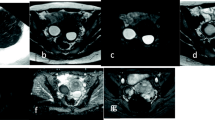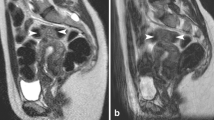Abstract
Purpose
In this study we aimed to investigate the value of contrast enhanced dynamic MR imaging (DMI) in the diagnosis of nodular abdominal endometriosis.
Subjects and methods
Fourteen patients with surgically and pathologically proven endometriosis were examined with DMI. The patients were 22–54 years old (mean age 30.8 years). The dynamic MR studies of these patients were retrospectively reviewed by two radiologists who were aware of the clinical data. Nodular masses showing enhancement were evaluated for size, margins, and signal intensity on T1- and T2-weighted MR sequences. The protocol was tailored to selectively determine the diagnostic utility of signal intensity time course analysis for the behavior of nodular endometriosis and endometrial tissue, in DMI. Contrast-enhanced DMI was performed and the time–intensity curves of the lesions and the uterine endometrial tissue of each patient were compared. Mean enhancement values were calculated. Each DMI was evaluated for signal intensity value.
Results
In 8 (57%) of 14 patients, we found endometriosis in the abdominal wall. All patients with abdominal wall endometriosis had pelvic surgical operation history. Diameter of nodular endometriosis determined in the abdominus muscle ranged between 3 and 40 mm. Of eight cases, five had only one lesion and three had multiple lesions. Remaining 6 (43%) cases had deep pelvic endometriosis located in the uterosacral ligaments (n = 3), rectosigmoid (n = 2), and rectovaginal septum (n = 1). Diameter of pelvic endometriosis ranged between 9 and 53 mm. Noncontrast mean signal intensity of endometriosis and endometrial tissue were 280 ± 73 and 216 ± 20, respectively. The mean values of both endometriosis and normal endometrial tissue were calculated for each patient examined with five-slice DMI. All of the curves showed significant correlation. The lesion showed significant enhancement in the course of time similar to the endometrial tissue in all patients.
Conclusion
Our study was inspired from the fact that endometriosis is the ectopic endometrial tissue and we thought that endometrial tissue and endometriomas should have similar vascularity. In this way imaging with MR, getting the time–intensity curves and experiencing the correlation between the endometriosis and endometrial tissue may support the diagnosis in the cases with suspected endometriosis. This first study shows that the ectopic nodular endometriosis can easily be identified with dynamic MRI. It may be used to differentiate nodular endometriosis from the other pathologic conditions of abdominal wall and pelvis.






Similar content being viewed by others
References
Blanco RG, Parithivel VS, Shah AK, et al. (2003) Abdominal wall endometriomas. Am J Surg 185:596–598
Sataloff DM, La Vorgna KA, McFarland MM (1989) Extrapelvic endometriosis presenting as a hernia: clinical reports and review of the literature. Surgery 105:109–112
Bumpers HL, Butler KL, Best IM (2002) Endometrioma of the abdominal wall. Am J Obstet Gynecol 187:1709–1710
Gougoutas CA, Siegelman ES, Hunt J, et al. (2000) Pelvic endometriosis: various manifestations and MR imaging findings. Am J Roentgenol 175:353–358
Siegelman ES, Cutwater E, Wang T, et al. (1994) Solid pelvic masses caused by endometriosis: MR imaging features. Am J Roentgenol 163:357–361
Kuhl CK, Mielcareck P, Klaschik S, et al. (1999) Dynamic breast MR imaging: are signal intensity time course data useful for differential diagnosis of enhancing lesions? Radiology 211:101–110
Siegmann KC, Muller-Schimpfle M, Schick F, et al. (2002) MR imaging-detected breast lesions: histopathologic correlation of lesion characteristics and signal intensity data. Am J Roentgenol 178:1403–1409
Erdem CZ, Bayar U, Erdem LO, et al. (2004) Polycystic ovary syndrome: dynamic contrast-enhanced ovary MR imaging. Eur J Radiol 51:48–53
Bazot M, Darai E, Hourani R, et al. (2004) Deep pelvic endometriosis: MR imaging for diagnosis and prediction of extension of disease. Radiology 232:379–389
Kinkel K, Chapron C, Balleyguier C, et al. (1999) Magnetic resonance imaging characteristics of deep endometriosis. Hum Reprod 14:1080–1086
Kaunitz A, Di Sant’Agnese PA (1979) Needle tract endometriosis: an unusual complication of amniocentesis. Obstet Gynecol 54:753–755
Tanaka YO, Yoshizako T, Nishida M, et al. (2000) Ovarian carcinoma in patients with endometriosis: MR imaging findings. Am J Roentgenol 175:1423–1430
Verstraete KL, Lang P (2000) Bone and soft tissue tumors: the role of contrast agents for MR imaging. Eur J Radiol 34:229–246
Seki H, Takano T, Sakai K (2000) Value of dynamic MR imaging in assessing endometrial carcinoma involvement of the cervix. Am J Roentgenol 175:171–176
Author information
Authors and Affiliations
Corresponding author
Rights and permissions
About this article
Cite this article
Onbas, O., Kantarci, M., Alper, F. et al. Nodular endometriosis: dynamic MR imaging. Abdom Imaging 32, 451–456 (2007). https://doi.org/10.1007/s00261-006-9038-7
Received:
Accepted:
Published:
Issue Date:
DOI: https://doi.org/10.1007/s00261-006-9038-7




